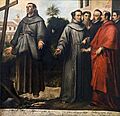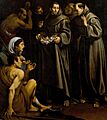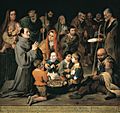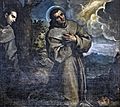Didacus of Alcalá facts for kids
Quick facts for kids SaintSaint Didacus of Alcalá O.F.M. |
|
|---|---|

San Diego de Alcalá by Francisco de Zurbarán
|
|
| Religious and Missionary | |
| Born | c. 1400 San Nicolás del Puerto, Kingdom of Seville, Crown of Castile |
| Died | 12 November 1463 (aged 62–63) Alcalá de Henares, Kingdom of Toledo, Crown of Castile |
| Venerated in | Catholic Church |
| Canonized | 10 July 1588, Saint Peter's Basilica, Papal States by Pope Sixtus V |
| Major shrine | Ermita de San Diego, San Nicolás del Puerto, Seville, Spain |
| Feast | 13 November, 7 November (Franciscan Order in the United States and the Roman Catholic Diocese of San Diego) |
| Attributes | Franciscan habit Cross Lily |
| Patronage | Roman Catholic Diocese of San Diego Franciscan Lay Brothers |
Didacus of Alcalá (Spanish: Diego de Alcalá), also known as Diego de San Nicolás, was a Spanish Franciscan lay brother. A lay brother is someone who joins a religious order but does not become a priest. He was one of the first missionaries to the Canary Islands. He passed away in Alcalá de Henares on November 12, 1463. Today, the Catholic Church honors him as a saint.
Contents
The Life of Saint Didacus
Didacus was born around 1400 in a small village called San Nicolás del Puerto in Spain. His family was poor but very religious. As a young boy, he chose to live like a hermit, which means living alone and dedicating oneself to prayer. He later joined a hermit priest for guidance.
Joining the Franciscans
Feeling a call to a religious life, Didacus joined the Franciscan Order. This group of friars follows the teachings of Saint Francis of Assisi. He became a lay brother at a friary in Arruzafa, near Córdoba. As a friar, he did many different jobs with his hands to help support the community.
During these years, he traveled to villages around Córdoba, Cádiz, and Seville. He would preach to the people there. Many people in these towns still feel a strong connection to him today.
Didacus the Missionary
Didacus was sent to a new Franciscan friary in Arrecife, on the island of Lanzarote. This island is part of the Canary Islands. The island had been taken over about 40 years earlier. Missionaries were still teaching the native Guanche people about Christianity. Didacus worked as a porter, which means he was in charge of the friary's entrance and welcoming visitors.
In 1445, Didacus was chosen to be the Guardian of the Franciscan community on Fuerteventura island. This was unusual because a lay brother usually didn't hold such a high position. But Didacus was chosen because of his great dedication, wisdom, and holiness. He stood up for the native people against the colonizers. Because of this, he was sent back to Spain in 1449.
Helping the Sick in Rome
In 1450, Didacus was called back to Spain. From there, he traveled to Rome to take part in a special event called a Jubilee Year. This was announced by Pope Nicholas V. He also went to witness the canonization of Bernardine of Siena, another important saint. Many pilgrims and friars came to Rome for these events.
An illness spread through the city. Didacus worked as an infirmarian, which means he cared for the sick. He spent three months helping people at the friary connected to the Basilica of Santa Maria in Ara Coeli. People at the time believed that many sick people he cared for got better in a miraculous way.
After this, he returned to Spain. He was sent to the Friary of Santa María de Jesús in Alcalá. He spent the rest of his life there, praying and thinking deeply about God. He died on November 12, 1463, from an infection. It was said that his body remained unchanged after death and smelled pleasant.
A chapel, called Ermita de San Diego, was built in his hometown between 1485 and 1514. This was to honor him and keep his remains there.
Honoring Saint Didacus
Didacus was made a saint by Pope Sixtus V in 1588. He was the first lay brother of the Franciscan Order to become a saint. His feast day is celebrated on November 13. This is because November 12, the day he died, was already a feast day for other saints. In the United States, his feast day is celebrated on November 7.
Didacus is the saint for whom the Franciscan mission in California was named. This mission later grew into the city of San Diego, California. He is also one of the patron saints of the Roman Catholic Diocese of San Diego.
The famous Spanish painter Bartolomé Estéban Murillo painted several pictures of Didacus of Alcalá.
Miracles of Saint Didacus
Many stories tell of miracles connected to Saint Didacus.
The Miracle of the Roses
Didacus often took bread from the monastery's kitchen to give to poor people. One day, as he was leaving the convent with his cloak full of food, he was stopped and asked to open his cloak. Miraculously, the loaves of bread had changed into beautiful roses!
Healing King Henry IV
Henry IV of Castile was on a hunting trip when he fell from his horse and hurt his arm badly. He was in terrible pain, and his doctors couldn't help him. He went to Alcalá and prayed to Didacus for healing. Didacus's body was taken from its casket and placed next to the king. Henry kissed the body and put Didacus's hand on his injured arm. The king felt the pain disappear, and his arm immediately became strong again.
Saving Prince Don Carlos
Don Carlos, Prince of Asturias, was the son of King Philip II of Spain. He was known for being difficult. One night in 1562, he fell down a flight of stairs in the dark and hit his head. He was found unconscious and partly unable to move the next morning. He later became blind, had a high fever, and his head swelled up a lot.
During a clear moment, he asked to pray to Saint Didacus. Didacus's body was brought to his room. The head of the convent placed one of Carlos's hands on Didacus's chest. The prince then fell into a deep, peaceful sleep. Six hours later, he woke up and said he had dreamed that Didacus told him he would not die. The prince then recovered from his serious injury.
Mechanical Monk Model
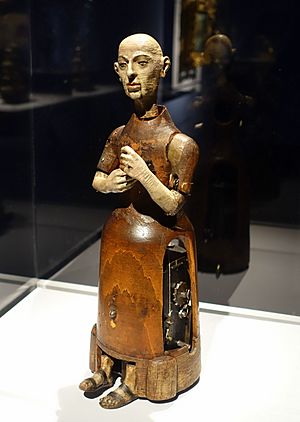
The Smithsonian Institution has a special clockwork automaton, which is like an old robot, in the shape of a monk. This model could perform several actions, including beating its chest, which is part of a prayer called Mea culpa.
It is thought that King Philip II of Spain might have ordered this model. He may have wanted to show the miracle of his son's recovery to his people. Or, perhaps the clockwork monk was a way to show people across the kingdom "how to pray."
Images for kids
-
The Miracle of Didacus of Alcalá by Bernardo Strozzi
-
Saint Didacus by Murillo, 1645–46
Gallery
-
Side altar icon in San Diego de Alcala Church, Philippines
See also
 In Spanish: Diego de Alcalá para niños
In Spanish: Diego de Alcalá para niños



